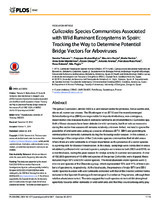Culicoides Species Communities Associated with Wild Ruminant Ecosystems in Spain: Tracking the Way to Determine Potential Bridge Vectors for Arboviruses
Autor
Talavera, S.
Muñoz-Muñoz, Francesc
Durán, Mauricio
Verdún, Marta
Soler-Membrives, Anna
Oleaga, Álvaro
Ruiz-Fons, Francisco
Estrada, Rosa
Pagés, Nitu
Arenas-Casas, Antonio
Editor
Public Library of ScienceFecha
2015Materia
CulicoidesRuminants
Farms
Livestock
Birds
Bird song
Bluetongue virus
Deer
METS:
Mostrar el registro METSPREMIS:
Mostrar el registro PREMISMetadatos
Mostrar el registro completo del ítemResumen
The genus Culicoides Latreille 1809 is a well-known vector for protozoa, filarial worms and,
above all, numerous viruses. The Bluetongue virus (BTV) and the recently emerged
Schmallenberg virus (SBV) are responsible for important infectious, non-contagious,
insect-borne viral diseases found in domestic ruminants and transmitted by Culicoides spp.
Both of these diseases have been detected in wild ruminants, but their role as reservoirs
during the vector-free season still remains relatively unknown. In fact, we tend to ignore the
possibility of wild ruminants acting as a source of disease (BTV, SBV) and permitting its
reintroduction to domestic ruminants during the following vector season. In this context, a
knowledge of the composition of the Culicoides species communities that inhabit areas
where there are wild ruminants is of major importance as the presence of a vector species
is a prerequisite for disease transmission. In this study, samplings were conducted in areas
inhabited by different wild ruminant species; samples were taken in both 2009 and 2010, on
a monthly basis, during the peak season for midge activity (in summer and autumn). A total
of 102,693 specimens of 40 different species of the genus Culicoides were trapped; these
included major BTV and SBV vector species. The most abundant vector species were C.
imicola and species of the Obsoletus group, which represented 15% and 11% of total numbers
of specimens, respectively. At the local scale, the presence of major BTV and SBV
vector species in areas with wild ruminants coincided with that of the nearest sentinel farms
included in the Spanish Bluetongue Entomological Surveillance Programme, although their
relative abundance varied. The data suggest that such species do not exhibit strong host
specificity towards either domestic or wild ruminants and that they could consequently play a prominent role as bridge vectors for different pathogens between both types of ruminants.
This finding would support the hypothesis that wild ruminants could act as reservoirs for
such pathogens, and subsequently be involved in the reintroduction of disease to livestock
on neighbouring farms.

